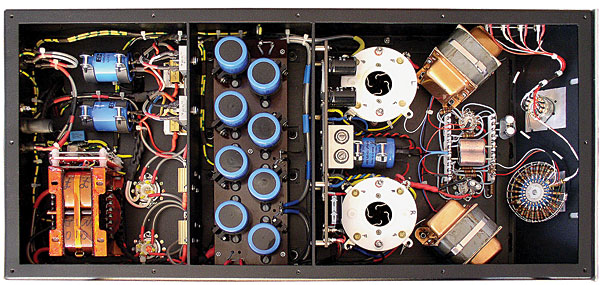| Columns Retired Columns & Blogs |
Drop dead gorgeous!
The Jinro also seemed to pass along deeper bass information than my reference preamp and amp, adding a bit of oomph to the sounds of certain lower-pitched instruments. The bass drum toward the end of Scene I of Vaughan Williams's Job was more powerful than usual; ditto the right- and left-hand timpani throughout XTC's "Sacrificial Bonfire," from a new reissue of Skylarking (45rpm LP, Ape APELP044D). The title track of Miles Davis's Bitches Brew: 40th Anniversary (LP/CD, Columbia/Legacy 88697 702742) was very damn scary, with an extra sense of menace to the otherworldly, broken-machine–like bass notes. And I was surprised at how huge and deep Bob Cranshaw's double bass sounded in "Yesterdays," from Sonny Meets Hawk (LP, RCA Living Stereo/Classic LSP-2712, and one of Classic's finest reissues), by Sonny Rollins and Coleman Hawkins (plus my esteemed neighbor Paul Bley on piano). On the other hand, the Jinro didn't have the same sense of scale as my Shindo combination of Masseto preamp and Corton-Charlemagne monoblocks, the latter sounding altogether bigger.

The Audio Note and Shindo electronics presented musical and sonic textures somewhat differently. The Jinro favored (drew my attention to might be more accurate) textures of a finer sort, such as the rosiny air-sheen that hangs around in the milliseconds following a violin note, or the shimmer of a ride cymbal under the hands of a good drummer. My Shindo gear, by contrast, seems to favor coarser, stringier sounds—for example, maximizing the hugely physical quality of the cellos and double basses that open Sir Georg Solti and the London Symphony's very Wagnerian version of Mahler's Symphony 2 (LP, Decca/Speakers Corner 325/6), or the fullback manner in which the same instruments make their entrance in the second movement.
Conclusions
Do single-ended triode amplifiers sound wonderful because they're uniquely true to the music, or do they sound wonderful because they falsify and misshape the music, however appealingly? In short: Do single-ended amplifiers sound wonderful because they're right or because they're wrong?
The question never ceases to fascinate me, but only because I love a good question; the part of my brain that writes the endings to things looks past the answer, because I don't really care: Absent proof that it causes cancer, impoverishes my family, or leads to demonic infestation, I like what I like. I think everyone ought to feel that way, but that's none of my business. Hell, if everyone liked Hank Williams 78s, there wouldn't be enough left for me.
The notion of a domestic audio amplifier that costs as much as a Subaru Forester, yet whose maker would have us know represents tremendously good value for the money, challenges us, and is precisely the sort of thing that pisses off a lot of middle-aged men—a group not known for its ability to resist being pissed off about matters less serious than cancer, poverty, and demonic infestation. Yet the big question remains: Do I think the Audio Note Jinro is a good value? In long: Do I see $26,500 worth of parts and/or design ingenuity in the Audio Note Jinro? And—do I hear $26,500 worth of sound when I listen to the Audio Note Jinro? The respective answers, of course, are No and Yes, I think so.
So I return to the Jinro's sweet tone, remarkable spatial qualities, and superior way of letting notes flow—arguably among the prime reasons for anyone to buy a $26,500 single-ended integrated amplifier in the first place. The Audio Note was beautifully, enchantingly involving; and, in concert with Audio Note's AN-E speakers, it sounded clear and clean and pretty much correct. While it's not the only amplifier to do so—certain other Shindos come to mind, not to mention various Lamms and maybe a few other products—the Jinro exists as an appealing alternative for those who can appreciate and afford that sort of thing: a wonderful, wonderful amplifier.


Every blossom in spring is as perfect as need be.
We enjoy racing our pet turtles, but, the magic is lost on them.
What was your favorite note in the song that just finished?
Streamer really pulls the music free of its digital dungeon.
Hurrah!